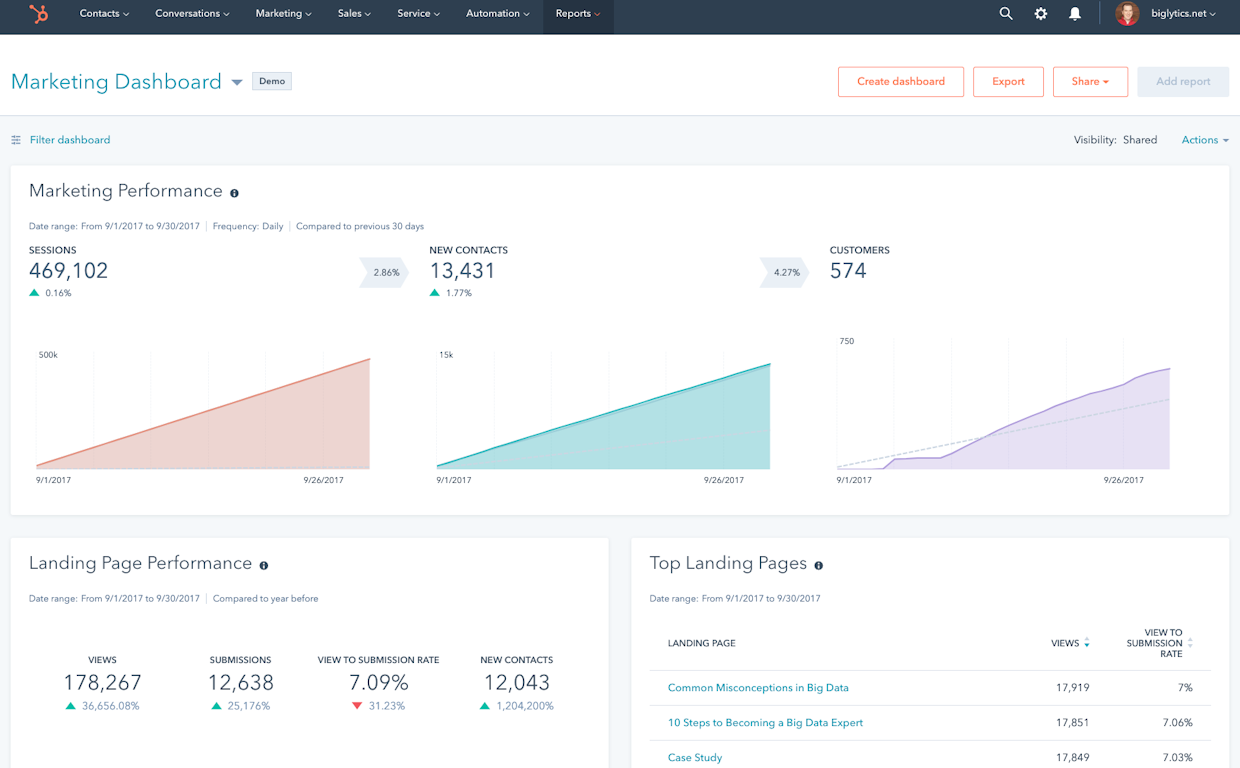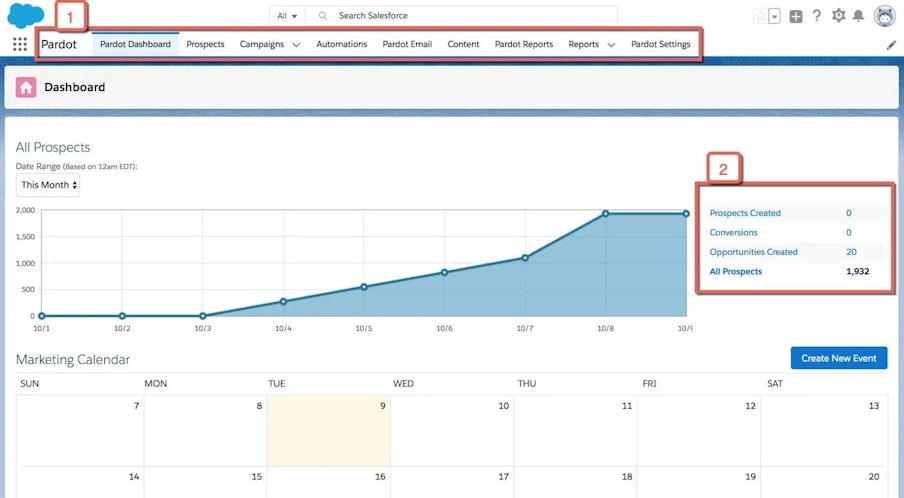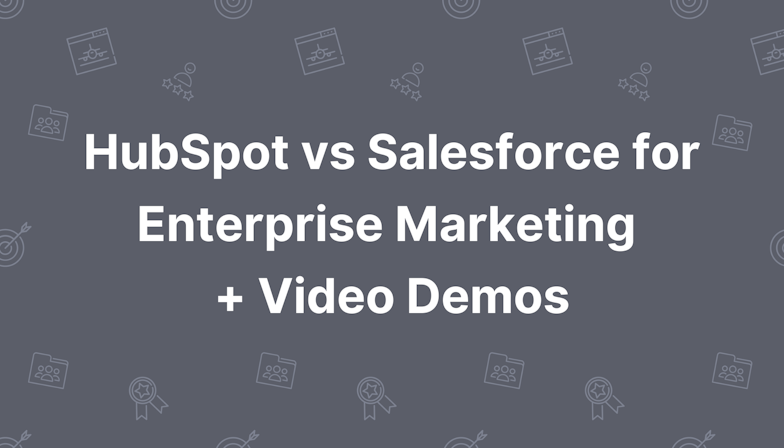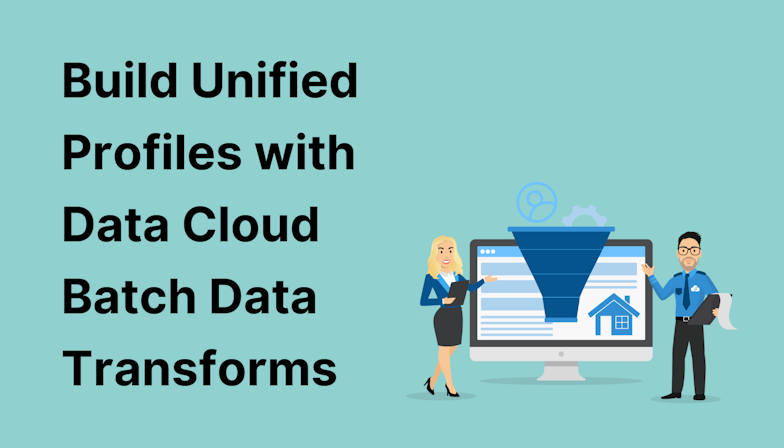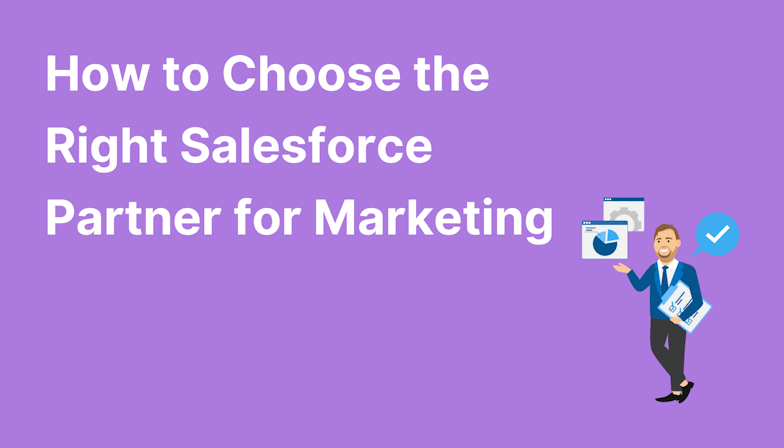Table of Contents
- Who is the target audience?
- Features overview
- CRM integration
- Data management
- Subscriber preferences
- Marketing and sales alignment
- Lead nurturing
- Campaigns
- Email marketing
- Landing pages
- Events and webinars
- Social media
- Reporting and analytics
- Interface and UX
- Training/available customer resources
- Which is right for you?
When it comes to marketing solutions, the Salesforce suite of products falls under the umbrella of ‘Marketing Cloud’, while HubSpot has the ‘Marketing Hub’.
It’s no wonder potential customers are confused about the differences!
To give you clarity, we’ve written a Salesforce Marketing Cloud vs HubSpot comparison that takes into account all of the features and capabilities of both. We’ve done this as objectively as possible. We’re not in the business of badmouthing any tool because, after all, they’re leaders for a reason.
Crucially, we’re doing this now because Salesforce recently launched a new product, called Marketing Cloud Growth, which could be viewed as more of a direct competitor to HubSpot than their other marketing automation platforms:
Marketing Cloud Engagement - formerly known as ExactTarget and with a primarily B2C customer base.
Marketing Cloud Account Engagement - formerly known as Pardot and with a primarily B2B audience.
For a more detailed comparison of Marketing Cloud Engagement and Account Engagement, read this blog post.
For the record, Salesforce has other marketing products, including Data Cloud, Personalization, Intelligence, and Einstein but given these are add-ons to the core Salesforce Marketing Cloud platforms above, we’ll be considering them as part of the overall product offering rather than comparing each individually.
Who is the target audience?
Before we take a look at the differences in available features and how well these stack up, it’s important to consider the intended target audience for both Marketing Cloud and HubSpot.
HubSpot describes its products as:
‘a cloud-based customer platform that helps scaling businesses grow better with marketing, sales, service, and content management engagement hubs.’
Note the word ‘scaling’. The translation is that HubSpot is primarily aimed at small and medium-sized businesses that are ambitious and fast-growing.
On the flip side, Salesforce has historically been an excellent enterprise solution. We’ll get into the nitty-gritty of why in the features overview section but take this line from the Marketing Cloud page, for example:
‘See how top brands activate data and AI with Salesforce to grow customer relationships.’
Note the words ‘top brands’. Now, top brands doesn’t have to mean enterprise businesses but most of us would take it to mean well-known, multinational companies rather than SMBs.
Obviously, there is overlap and use cases where enterprises are using HubSpot and SMBs are using Marketing Cloud but generally, we can look at the products as being best suited to different business sizes.
Features overview
Any premium marketing automation tool should help marketers master:
CRM integration
Data management
Subscriber preferences
Marketing and sales alignment
Lead nurturing
Campaigns
Email marketing
Landing pages
Events and webinars
Social media
Reporting and analytics
It should also consider things like:
Interface and user accessibility
Training/available customer resources
Both HubSpot and Marketing Cloud have pros and cons. Below, we discuss what those are, with direct comparisons but let’s also highlight a couple of key points.
In our opinion, the versatile features of Marketing Cloud make it a clear winner for enterprise businesses. In Marketing Cloud Engagement, you have access to SQL and relational data modelling which means anything is possible when it comes to segmentation and data management. While Account Engagement has B2B features that HubSpot doesn’t, such as custom lead scoring and grading.
On the other hand, the easy-to-use features and user-friendly interface of HubSpot mean less of a learning curve for its customers and because the Marketing Hub has been around for longer than Salesforce’s newest small business product, Marketing Cloud Growth, marketers can currently do more… for now (there’s no doubt MC Growth will evolve quickly!).
Now, into the nitty-gritty.
Salesforce Marketing Cloud vs HubSpot by features
CRM integration
Boasting a CRM market share of 24%, Salesforce is the most widely used CRM software. So for the purposes of looking at CRM integration, it’s helpful to use Salesforce as an example - this isn’t us being biased!
HubSpot
Has a native Salesforce integration
Offers a HubSpot CRM
Can integrate with third-party CRMs via app and API
In our experience, the HubSpot to Salesforce data transfer can result in a mismatch of naming conventions and limits in the type of data exchange, including being unable to carry HubSpot lists over to Salesforce.
Marketing Cloud
Has deep and seamless integration with Salesforce
Possible to integrate with third-party CRMs via ‘Connectors’
If you’re a Salesforce CRM user, there’s no beating the level of integration you can achieve when using other Salesforce products. Naturally, the setup is easy and the possibilities for sharing data are far superior than any other platform!
Data management
HubSpot
Has dedicated ‘data quality’ reporting
Includes a data quality command centre
Easy to spot duplicates and sync issues
A strength of HubSpot is definitely in how simple it is to monitor your data hygiene, including identifying duplicates and discrepancies in formatting. You can also set up notifications if duplicate data hits a set limit, and manage data from the data quality command centre.
Marketing Cloud
Managing data hygiene is less ‘out-of-the-box’
Data storage is more flexible in Marketing Cloud Engagement
Data Cloud add-on makes it possible to unify prospect data from all sources
In terms of staying on top of data quality, HubSpot is great. However, it’s not as easy to pull data from multiple sources into one place, something that Salesforce has a dedicated solution for; Data Cloud.
Subscriber preferences
HubSpot
Has a default preference centre
Can edit the preference page look and feel
The default preference centre in HubSpot makes it easy for prospects to manage their preferences by adding and removing themselves to lists, or unsubscribing. However, there are limitations when it comes to fully customising the page.
Marketing Cloud
Products come with a default preference centre
In Account Engagement, can use a Page Layout Template to fully customise
In Marketing Cloud Engagement, can build using CloudPages and AMPscript
Preferences management is far simpler in Account Engagement than in Marketing Cloud Engagement, which requires knowledge of AMPscript if you want to build a page from scratch.
Marketing and sales alignment
HubSpot
Requires Enterprise plan to create dashboards by user
No lead grading capabilities
Marketing Cloud
Seamless integration means greater data sharing
Automated lead handover
Connected Users allows for syncing between sales and marketing
B2B Marketing Analytics equals complete reporting
The advantages of having fully integrated sales and marketing systems is that data and assets can be easily shared. Lead handover and source attribution is fully automated, meaning rapid response times and higher win rates. Plus, for Account Engagement users, B2BMA pulls data from both Sales Cloud CRM and Account Engagement into dashboards, for better reporting.
Lead nurturing
HubSpot
Has predictive lead scoring
No lead grading for whittling out irrelevant prospects
Sophisticated marketing automation journeys
HubSpot is known for its inbound marketing capabilities so naturally, lead nurturing is a strong point. With predictive lead scoring, it’s easy to see which prospects are most likely to convert and creating automated lead nurturing campaigns is very straightforward. However, there is no lead grading, which means irrelevant prospects can stay in lists and skew reporting.
Marketing Cloud
Account Engagement has both scoring and grading
Also has Einstein Behaviour scoring
Marketing Cloud Growth uses Engagement Score
Account Engagement has extensive lead nurturing capabilities, with both scoring and grading features that are fully customisable. It also uses AI via Einstein to give prospects behaviour scores and the newest product, MC Growth, uses a blended model of scoring and grading to score prospects on their levels of engagement.
Campaigns
HubSpot
Group activity and assets into Campaigns
Single asset can only exist in one Campaign
Campaign reporting is very visual and easy to access
The real advantage of running Campaigns in HubSpot is that reporting dashboards are incredibly easy to use, with little to no manual setup. Campaign reports also come with great collaboration tools, such as a comments functionality for team members. However, only being able to group an asset into one campaign isn’t ideal because sometimes, a single form or landing page may be used for multiple.
Marketing Cloud
Group activity and assets into Campaigns
Connected Campaigns aligns Sales Cloud and Account Engagement
Use B2BMA for extensive campaign reporting
Crucially, in both Account Engagement and Marketing Cloud Engagement, it’s easy to group assets into multiple campaigns. In Account Engagement, we also have the ‘Connected Campaigns’ feature, which pulls Salesforce ‘Opportunity’ metrics into reports. Using B2BMA, we can display key attribution details on dashboards.
Free Guide to Salesforce Tools
With the eBook ‘A Guide to Salesforce Marketing Tools’ in your arsenal, you’ll have a go-to, comprehensive, expert guide to understanding and selecting your perfect Salesforce marketing platform(s).
- The Salesforce ecosystem
- Understanding Salesforce tools
- Choosing your Salesforce tools
- Implementation tips
- Build your business case
- Free quiz
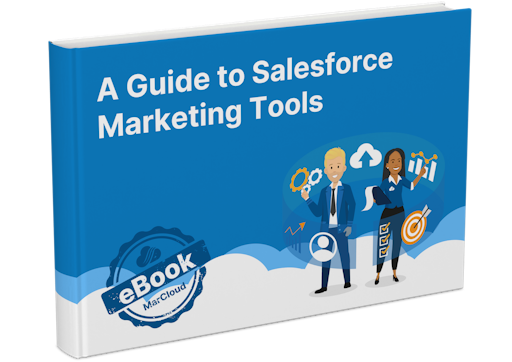
Email marketing
HubSpot
Drag-and-drop email builder
Reusable templates
Some daily and monthly email limits
Convoluted ‘smart rules’ for using dynamic content
With great UX, building and sending emails in HubSpot is a smooth ride. The drag-and-drop builder makes it easy for non-coders and you can save templates to use time and again. Depending on how quickly your list grows and which subscription you opt for, you might face limitations of the number of emails you can send.
Marketing Cloud
Drag-and-drop email builders in all marketing products
Email Studio comes with option for HTML or WYSIWYG
Great dynamic content capabilities
In all of the Marketing Cloud platforms, building and sending emails is simple but importantly, it’s also very easy to create HTML content, which means more control over how emails display in the inbox. Plus, using dynamic content in emails is possible without creating hundreds of lists! In Marketing Cloud Engagement’s Email Studio, it’s as simple as selecting the ‘Dynamic Content’ block and setting your rules based on data points.
Landing pages
HubSpot
Drag-and-drop landing page builder
Intuitive to use
A/B testing (with limits on the number of variants)
Like its email builder, HubSpot makes it very simple to build landing pages without any coding skills. A/B testing is available so you can test the elements of your page too, although there are some restrictions around how many variants you can create.
Marketing Cloud
Drag-and-drop landing page builder
Able to edit using HTML
Multivariate testing provides a sophisticated way to test page content
The interface may not be quite as slick as HubSpot but both Account Engagement and Marketing Cloud have easy-to-use builders that allow for drag-and-drop and HTML editing. Marketing Cloud Growth, however, has launched with guided creation and impressive AI functionality, making setup super simple!
Events and webinars
HubSpot
Event registration via apps in the HubSpot Marketplace
No built-in event facilitation
A few integrated webinar providers
If you’re running events, online or offline, using third-party event tools such as Eventbrite, you can install the relevant app from the HubSpot Marketplace and use it to create contacts and trigger workflows. HubSpot also integrates with well-known webinar providers, such as Zoom, in this way.
Marketing Cloud
Event management via ‘Connectors’
No built-in event facilitation
Connectors for popular webinar tools
Much the same as HubSpot, with Marketing Cloud products you can connect to third-party event registration tools and sync some of the data, using it to add attendees to lists. However, there are known limitations, such as being unable to add to Campaigns.
Social media
HubSpot
Manage social channels directly within HubSpot
Social interactions recorded in CRM
Attribution for social activity in campaign reporting
There’s no arguing with the fact that HubSpot is fantastic for social media functionality. Not only can you schedule posts to social channels, you can also monitor keywords and mentions, as well as send interaction data straight into your CRM. What’s more, social media management tools use AI to aid posting.
Marketing Cloud
Post to social channels directly
Run social media advertising campaigns via MC Engagement
Pull social clicks into prospect profiles
The strongest social media features in Marketing Cloud can be found in the Marketing Cloud Engagement platform. Social Studio enables marketers to publish straight to their channels from inside MC Engagement, while Advertising Studio makes it possible to not only run ad campaigns but to include these as automated activities in Journey Builder.
Reporting and analytics
HubSpot
Nice out-of-the-box dashboards
Multi-channel reporting and attribution
Reporting limitations on some plans
Viewing HubSpot reports is a delight. They’re clean, visually appealing, and can do the heavy lifting of telling you exactly which assets are contributing to sales revenue. Customising the reports or creating more than one isn’t possible unless you’re on an Enterprise plan, so if you require metrics or drill-downs i.e. traffic reporting by device type, you’ll be hamstrung.
Marketing Cloud
B2BMA combines metrics from Salesforce and Account Engagement
Marketing Cloud Engagement notoriously difficult to report on
Marketing Cloud Growth comes with built-in dashboards
Your experience with reporting and analytics in Marketing Cloud depends on the platform you’re using. Account Engagement has some nice reporting features but it’s B2BMA that gives it an edge. This app allows you to pull sales and marketing information into a single place, to create custom reports. Marketing Cloud Engagement is less advanced, with basic analytics. While MC Growth comes with a tab dedicated to reporting and analytics.
Interface and UX
HubSpot
Clean interface, nicely designed with plenty of visuals
Easy to navigate
Designed for SMBs to pick up and run with little to no training, HubSpot is a brilliantly visual tool that’s simple to use.
Marketing Cloud
Marketing Cloud Growth is clean and guides you through
Account Engagement is simplistic but less visual
Older Studios in Marketing Cloud Engagement are clunky
Again, the latest product released by Salesforce is super easy to use and comes with guided steps for campaign and asset building, as well as extensive AI. We love the interface of Account Engagement but can appreciate it’s less visual than HubSpot, while Marketing Cloud Engagement has nice designs for newer Studios and Builders, such as Journey Builder, while others could do with a revamp.
Training/available customer resources
HubSpot
HubSpot Academy for free certifications
Free resources and extensive blog
Support channels depending on your plan
HubSpot customers can study and earn certifications in various areas of inbound marketing, as well as resorting to the Knowledge Base with questions about the platform. Personalised support is only available via chat and email unless you’re on Professional or Enterprise plans.
Marketing Cloud
Huge community of ‘Trailheads’ meaning peer support is great
Trailhead for training programs and certifications
Support channels depending on your plan
Something that stands out in the Salesforce community, is how passionate its users are! There are so many resources, forums, and avenues of support from users themselves but failing that, Salesforce offers varying levels of support depending on your platform and edition.
Which is right for you?
Ultimately, both Salesforce Marketing Cloud and HubSpot have strengths and weaknesses and of course, both will evolve in time. Which is the right choice for your business depends on your marketing strategy, business structure, and budget.
Hopefully, this post has helped you to learn which features of each tool are most aligned with your plans but if you want to chat through your options with an expert, feel free to reach out. We may be Salesforce consultants but our success depends on your success, and the last thing we want to do is implement or manage a tool that doesn’t do what you need it to!
If you find yourself needing help with the HubSpot-Salesforce integration, contact us. On the other hand, if you’re set on Salesforce Marketing Cloud but need to decide between Account Engagement, MC Engagement and MC Growth, get in touch and we’ll give you an opinion based on your objectives.

Tom Ryan
Founder & CEO of MarCloud, Tom has been on both sides of the fence, client-side and agency, working with Salesforce platforms for the best part of a decade. He's a Salesforce Marketing Champion and certified consultant who loves to co-host webinars and pen original guides and articles. A regular contributor to online business and marketing publications, he's passionate about marketing automation and, along with the team, is rapidly making MarCloud the go-to place for Marketing Cloud and Salesforce expertise. He unapologetically uses the terms Pardot, Account Engagement and MCAE interchangeably.
More by Tom RyanFeatured resource

Salesforce Marketing Tools
With the eBook ‘A Guide to Salesforce Marketing Tools’ in your arsenal, you’ll have a go-to, comprehensive, expert guide to understanding and selecting your perfect Salesforce marketing platform(s), be it Marketing Cloud Account Engagement (Pardot) or Engagement, and the products available to each.
Download now